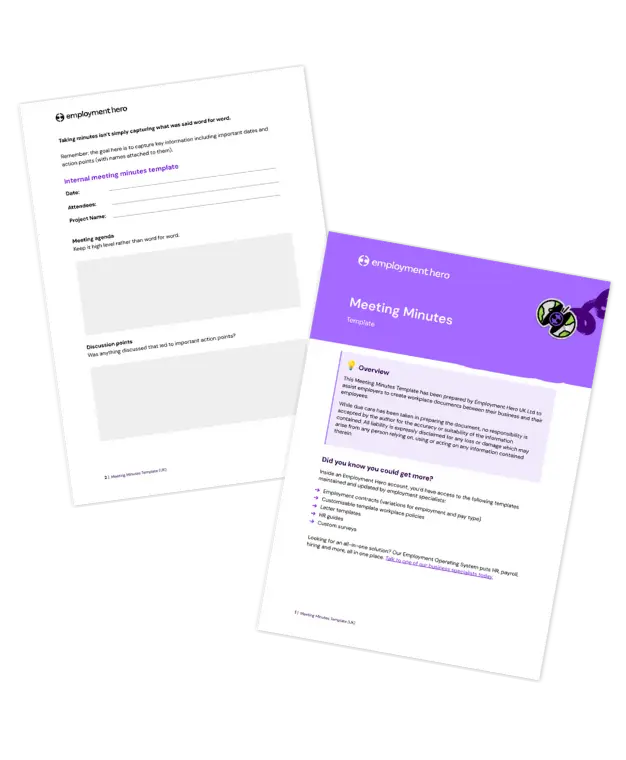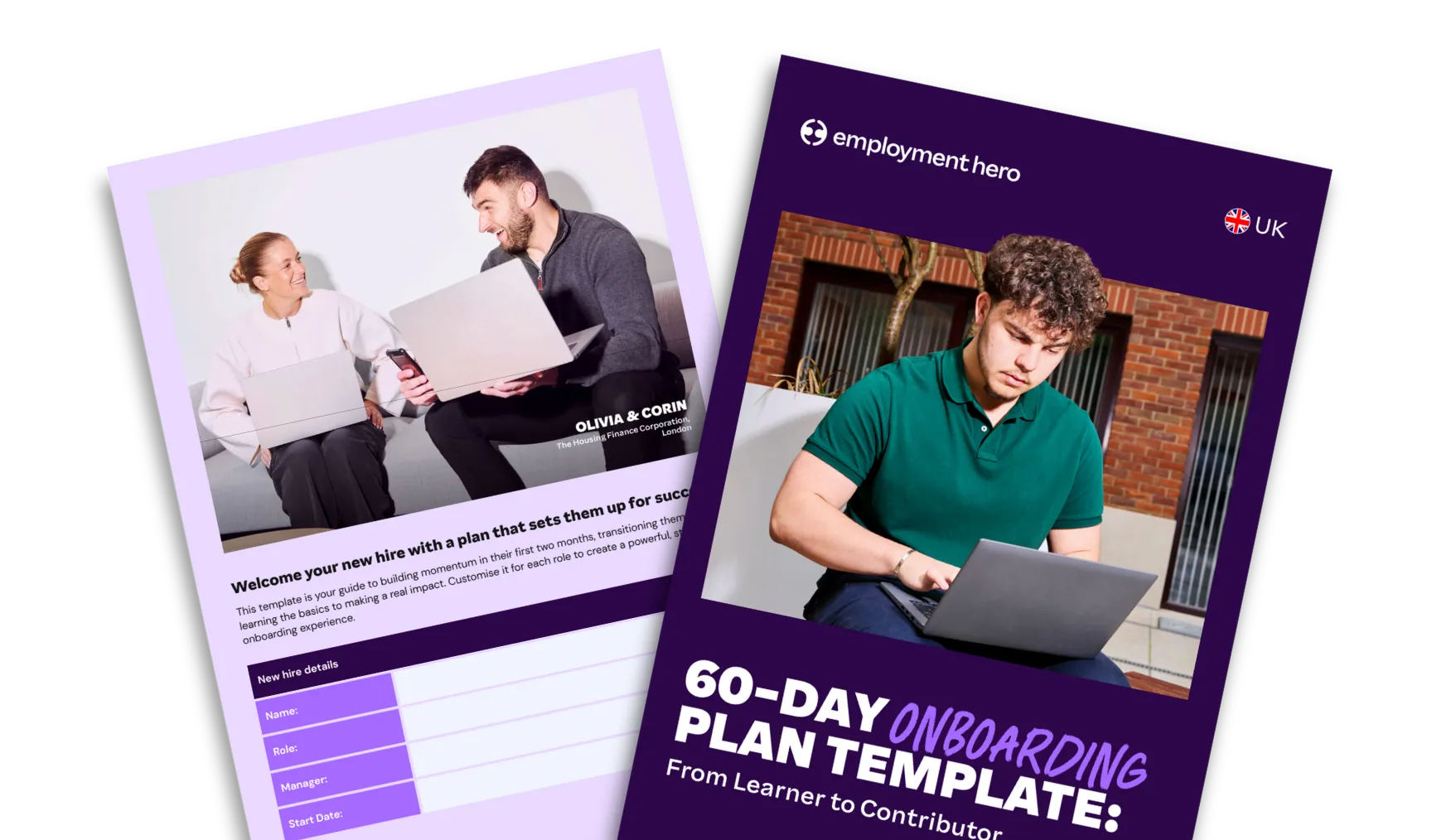Meeting minutes template [free download]
Published
Meeting minutes template [free download]
1 min read
Ever attended a meeting for key discussions only to forget what it was about as soon as you stepped outside the room? If that’s the case, you already know why taking minutes is important.
Make it easy to start taking minutes with this quick guide and our free meeting minutes template.
Download the free template using the form to the right.

What are meeting minutes and why are they important?
Meeting minutes are a written record of key subjects and decisions taken during a meeting. They cover things like when the meeting happened, topics that were discussed, important details that were shared, any motions or decisions taken and what the outcomes were.
They’re not a complete transcription of the meeting, but rather a summary that can be used at future meetings or as a way to refer back to see what important things happened at a past meeting.
The importance of meeting minutes is their use in accountability and compliance. This can range from remembering what was discussed in a previous meeting so topics can be picked up again, to covering what gets covered and agreed upon in a client meeting in order to create a statement of work.
It’s easy to misremember conversations or forget certain details, so minutes provide that reliable touchpoint to which everyone can refer back, keeping things open and transparent.
What should meeting minutes include?
Meeting minutes should provide a clear and understandable record, covering all the important details and outcomes. The type of meeting will dictate the specifics needed in the minutes, but in general they should include:
- Date and time of the meeting.
- Who attended the meeting, and who was absent.
- Review of the previous meeting’s minutes, and if they are accepted or need amending.
- The meeting agenda.
- Discussions or decisions taken about each item on the agenda.
- Next steps or timelines for activities agreed upon.
How to use this template effectively
To make this meeting minutes template useful, there are a few steps to take both before and after the meeting itself. Successfully recording minutes just takes a bit of planning and preparation.
- Plan ahead. Hopefully you’ll know about the meeting well in advance of it taking place, which means you’ll have an agenda. This will allow you to use the topics to prepare the structure of your minutes, with space to record what gets discussed under each heading. You’ll also hopefully have a list of attendees to add, as well as the date and time of the meeting.
- Clarity and brevity. Taking minutes isn’t about recording every word spoken in a meeting. The trick is to capture key details and decisions, so don’t worry about trying to write absolutely everything down. Take clear and simple notes you can refer to afterwards.
- Follow up. Once the meeting ends, it’s best to write up the minutes as soon as possible while everything is fresh in your mind. Share the final version if required, or file them for future reference. Make it even easier by using management software to keep track of meetings and minutes.
Who is this meeting minutes template for?
We’ve designed this template to be adaptable to a wide range of businesses, industries and roles, making it useful for almost any kind of meeting. This meeting minutes template will work for:
- HR professionals. Properly minuted meetings can be crucial in HR, so have this template ready to go whenever you need it.
- Managers. Use this template for important team meetings, so everyone has reliable and clear minutes to refer back to.
- Project leaders. Accountability and organisation are so important in project management, so make sure the vital information is recorded.
- Assistants. As a professional assistant, you know you have to be ready for almost anything, so have this template in your files ready to use at a moment’s notice.
- Startup teams. Those early days setting up a successful business always involve plenty of important meetings. This minutes template makes sure those important decisions and actions can be recorded.
Minute-taking best practice
Once you’ve got your meeting minute template ready to go, there’s the task of actually taking the minutes. You should use whatever note-taking approach works best for you, but we’ve got some best-practice tips to help you become a minuting pro.
- Take concise notes. Don’t try to write down everything said in a meeting (unless you’re adept at shorthand). The aim is to record the important points, not every single opinion, so focus on headline discussions and decisions.
- Stay neutral. Minutes should provide a fly-on-the-wall perspective, not the perspective of the person writing them. Stick to the facts and avoid personal remarks.
- File your minutes. Minutes are only useful if they’re easy to find and reference, so keep your files organised. If you’re covering a lot of meetings with employees, make use of our performance management software to streamline your approach.
- Share and review. Just as you should write up the minutes as soon as possible after the meeting, aim to share them quickly, too. This means people can review them with the meeting fresh in their minds, helping with accuracy and reliability.
Download the meeting minutes template
Get started on your productive meeting journey and download our free meeting minutes template today.
Meeting minute FAQs
A good minutes format should include things like the date and time, attendees and absentees and the full range of discussion points and decisions taken. Use our free meeting minutes template to make sure you’re covering everything.
The best way to write meeting minutes is to use the meeting agenda to make clear and concise notes as each item is discussed. Keep your notes brief and clear, capturing anything important rather than every detail.
The only meetings that legally require minutes in the UK are company board meetings and general meetings. The minutes act as official records of these important meetings, recording decisions and discussions that affect entire companies.
Yes, you can adapt this meeting minute template for use in almost any type of meeting, including board and client meetings.
Register for the downloadable
Related Resources
-
 Read more: Predictive Modelling in HR: Stop Guessing, Start Winning
Read more: Predictive Modelling in HR: Stop Guessing, Start WinningPredictive Modelling in HR: Stop Guessing, Start Winning
Discover how predictive modelling in HR can transform decision-making. Learn about key models, algorithms and steps to implement predictive analytics.
-
 Read more: Team Cohesion: The Ultimate Toolkit For Cross-Functional Collaboration
Read more: Team Cohesion: The Ultimate Toolkit For Cross-Functional CollaborationTeam Cohesion: The Ultimate Toolkit For Cross-Functional Collaboration
Learn how to build team cohesion and improve cross-functional collaboration. Discover actionable strategies, team-building activities and key behaviours.
-
 Read more: Your 60 day onboarding plan: The free template for building momentum
Read more: Your 60 day onboarding plan: The free template for building momentumYour 60 day onboarding plan: The free template for building momentum
Download a free 60 day onboarding plan template. Learn how to set clear goals, track progress and ensure new hire…



















